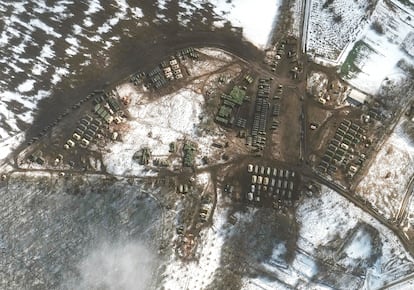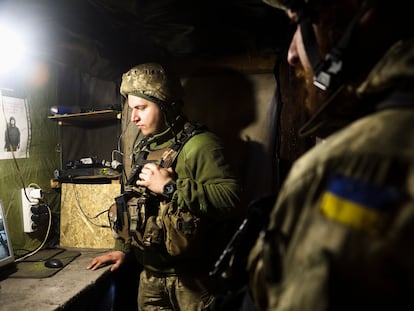The war in Ukraine via TikTok: How ordinary citizens are recording Russian troops
Videos of tanks near the border have been all over the internet in recent days, and serve for intelligence purposes. This is one of the digital fronts of the ongoing conflict
Russian tanks are circulating on TikTok. On the fastest-growing social network, there are videos like the one that Maria02903 shot from her car, and in which a column of tanks is visible, traveling down a frozen highway 10 kilometers from Ukraine.
In recent days, many videos like these of Russian troops being deployed have been posted, most taken by casual observers. There are planes, trucks, tracked vehicles and rockets. In a clip from February 8, a driver overtakes a very long line of armored vehicles, which appear to be reaching their destination. In another video, a man walking his dog appears to cross paths with what appears to be a ballistic missile launcher, according to The Washington Post. Many of these videos were shot on the border between Russia and Ukraine, where Russian President Vladimir Putin had already deployed some 190,000 soldiers.
Armed conflicts are also digital. This has been the case for a decade now, but the phenomenon has grown hugely since then. We are all carrying a camera around with us, more people record images, and sharing them can be done in a second. It’s inevitable. But it is still strange – on TikTok, a teenager from northern Spain can skip in two seconds flat from watching a dance routine, to footage of a Russian MiG-31K landing in Belarus.
The videos are an interesting detail, but the Russian offensive in Ukraine is a conflict that has at least three digital fronts.
An information war. Which troops is Russia deploying? Where are they? Which vehicles does it have? These typical questions asked by intelligence services can now be answered using open sources. With TikTok videos and images from non-military satellites, Michael Sheldon, an analyst at the Digital Forensic Research Lab, shared two images on Twitter from the Tomarovka airfield in Russia (located just 30 kilometers from Ukraine) taken with the Sentinel-2 satellite from the European Space Agency. Comparing images from February 5 and 15, he claimed to be able to see a dozen new aircraft. “Each new dot likely represents an [Mi-24] helicopter, so about a dozen visible in this imagery,” he stated.
Sentinel-2 imagery of the new helicopter base at Tomarovka airfield, geolocated by @bobmoretti.
— Michael Sheldon (@Michael1Sheldon) February 17, 2022
Comparison between Feb 05 and 15. https://t.co/Ap0AepRFXt pic.twitter.com/4SYRuvWiy3
There is a disinformation war (both for and against). Anyone can share an image and make it look like something it is not. That is what the pro-Russian separatists in the regions of Donetsk and Luhansk are doing, with the support of Russia, by sharing videos accusing the Ukrainian army of attacks that they deny having carried out. A number of Western experts have questioned these images (the sound of gunfire, for example, is copied from another, older video on YouTube). They also believe that these claims were used as a pretext to justify sending troops to the region, something that eventually happened on Monday. In the words of the former Ukrainian defense minister, Andriy Zagorodnyuk, “none of that has happened. It’s basically a virtual war, a war that exists in the IT space. It doesn’t exist in reality.”
It’s an example of the double-edged sword that is the internet. It allows for researchers to verify propaganda, wherever it may come from, but it is also a breeding ground for lies. On Twitter, Reddit and TikTok, the noise is deafening.

There is a war for information infrastructure. A strategic objective in the conflicts of the future will not be bridges or airports, but rather servers and computer networks. Ukraine has reported two recent cyberattacks, one in January and the other last week. The latest hack attacked government and army websites, and also the servers of the two biggest banks in the country. Other previous attacks have managed to cut off the electricity supply, cripple thousands of computers and even affect supermarket cash registers. Cyberattacks have been going on in the country since 2014, as part of what the authorities define as a “hybrid war” in Russia against Ukraine.
But let’s return to the TikTok videos, because in those we also get a glimpse of the other war, the analog one, which is mundane, historic, the worst and the most important. I’m referring to that suffered by the residents of Donbas, who are without water or electricity, trapped for eight years between the army and the pro-Russian separatists. The victims of the war are also going to be in those viral videos – they won’t be in the frame, in which we will see tanks on the snow and projectiles illuminating the sky, but on the other side of the camera, holding a cellphone.
Tu suscripción se está usando en otro dispositivo
¿Quieres añadir otro usuario a tu suscripción?
Si continúas leyendo en este dispositivo, no se podrá leer en el otro.
FlechaTu suscripción se está usando en otro dispositivo y solo puedes acceder a EL PAÍS desde un dispositivo a la vez.
Si quieres compartir tu cuenta, cambia tu suscripción a la modalidad Premium, así podrás añadir otro usuario. Cada uno accederá con su propia cuenta de email, lo que os permitirá personalizar vuestra experiencia en EL PAÍS.
¿Tienes una suscripción de empresa? Accede aquí para contratar más cuentas.
En el caso de no saber quién está usando tu cuenta, te recomendamos cambiar tu contraseña aquí.
Si decides continuar compartiendo tu cuenta, este mensaje se mostrará en tu dispositivo y en el de la otra persona que está usando tu cuenta de forma indefinida, afectando a tu experiencia de lectura. Puedes consultar aquí los términos y condiciones de la suscripción digital.
More information
Últimas noticias
Maduro pleads not guilty before the federal court in New York: ‘I am still the president of Venezuela’
A new test can detect Alzheimer’s from a finger prick
UN team enters Sudanese city of El Fasher after paramilitary massacre: ‘It’s like a ghost town’
A recipe for resistance: Indigenous peoples politicize their struggles from the kitchen
Most viewed
- Gilles Lipovetsky: ‘If you want to live better and fall in love, take Prozac, don’t look to philosophy’
- Alain Aspect, Nobel laureate in physics: ‘Einstein was so smart that he would have had to recognize quantum entanglement’
- Alvin Hellerstein, a 92-year-old judge appointed by Bill Clinton, to preside over Maduro’s trial in New York
- Why oil has been at the center of Venezuela-US conflicts for decades
- Maduro’s downfall puts China’s relationship with Venezuela to the test










































